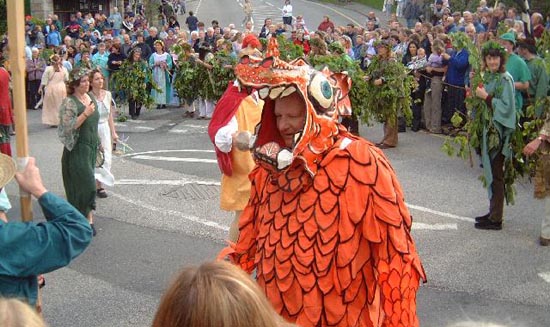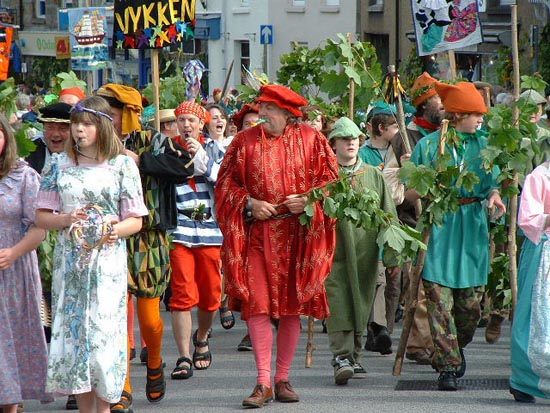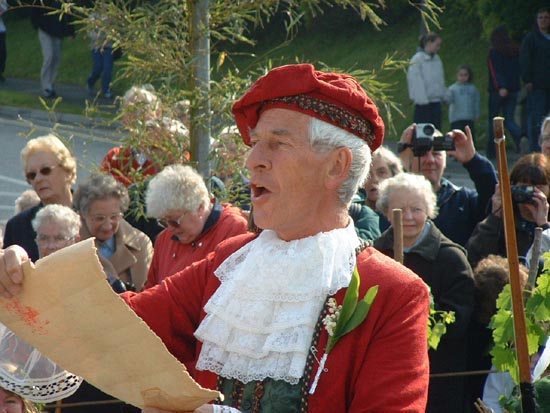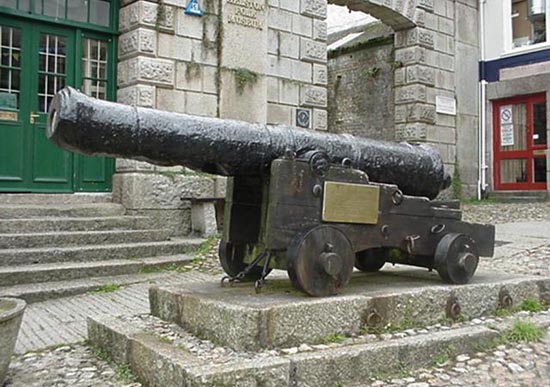The Helston Furry Dance
by John Ravenscroft
If you visit Helston in Cornwall and ask one of the locals about the famous Furry Dance, you're likely to hear the following story:
Satan, for reasons best known to himself, was flying through the air one night carrying a huge boulder with which to block the entrance to Hell. He was spotted by a keen-eyed St Michael, and a great battle ensued, during which Satan dropped his boulder. It fell to earth, trailing a terrible tail of fire, and shaking both the air and the ground with a mighty reverberation. The spot where it eventually landed became known as Hell's Stone.
In the fullness of time, Hell's Stone evolved into the pleasant market town of Helston, which you'll find midway between Falmouth and Penzance, and which is well worth a visit. (I don't know for sure where you'll find the entrance to Hell, but I can think of one or two places that might fit the bill.)

Of course, good always triumphs, and St Michael won his battle with Satan. The local people were so overcome with joy they began dancing in the streets -- and the tradition of The Helston Furry Dance was born.
Visitors who are unconvinced by this tale may be given the alternative account of The Great Fiery Dragon. This creature (it's been suggested it may have been a meteorite) is supposed to have fallen to earth at the spot now known as Angel Yard. The locals who witnessed the event were terrified, but when they saw that their town wasn't actually going to be destroyed, they were so relieved they gathered into groups and began dancing through the open houses.
Whatever its true origin, the Helston Furry Dance certainly goes back a long way. It's probably pre-Christian and may have started life as one of the many pagan rituals designed to welcome the returning warmth and new life of Spring after the bleak, cold death of Winter.
It's a Dance? And it's Furry?
Some say the Furry Dance takes its odd name from the old English word 'Faddy' which meant 'to go forward in a dance', but most authorities disagree with this notion. They maintain that the name comes from the Celtic word feur, which signified a festival. Similar festivals used to take place elsewhere in Cornwall -- on May 1st there was a dance at the Lizard and on May 3rd there was one at Penrhyn -- but only the May 8th festival at Helston survives. Helstonians, who claim it has taken place every year without a break except in times of war, certainly make the most of it.
Dance Children, Dance...
Preparations for the big day begin in mid-April when groups of gatherers descend on the estates of Trevarno, Penrose and Trelowarren to cut branches of sycamore, beech and various other specimens of greenery. These are used to decorate public and private buildings throughout the town. Meanwhile, people are busy painting their fences, smartening up their gardens and generally doing all they can to make the most of their houses before the festival brings in the crowds. In the local schools, time is devoted to putting pupils through their paces to ensure they perform well in the Childrens' Dance. This starts at 10.00 am and involves over 1,000 children aged from 7 to 18, all dressed in white. They come from St Michael's School, Nansloe School, Parc Eglos School and the Helston School and Community College. Onlookers with an eye for detail can match pupils to schools by the colours of the boys' ties, and by the flowers the girls wear in their head-dresses.
 The children aren't the only ones dancing on the day, though. The Early Morning Dance begins at 7.00 am. Hundreds of local people gather in the streets and wait for the town clock to strike. When it does, the Town Band begins to play and the first Dance of the day begins. The dancers move in and out of the houses and gardens, most of them wearing lilies-of-the-valley, a flower that has long been associated with the festival.
Hal-an-Tow
At about 8.00 am, after the Early Morning Dance has run its course, Robin Hood, Friar Tuck, St George and St Michael (along with several other performers of the 'Hal-an-Tow' Pageant) gather at St John's Church and begin their tour of the town. They stop at designated points here and there and act out battles in which good defeats evil. When they're not fighting, they're singing the ancient Hal-an-Tow song, the chorus of which makes the true purpose of this ritual clear:
With Hal-an-Tow! Jolly Rumble, O!
For we are up as soon as any day, O!
And for to fetch the Summer home,
The Summer and the May, O,
For Summer is a-come, O,
And Winter is a-gone, O.
The Mid-Day and Five O'Clock Dances
At noon the principal dance begins. This is an exclusive affair, participation being by invitation only, and formal dress is required. Ladies are required to wear full-length dresses, hats and gloves, and their partners are expected to be in black morning dress, with ties and grey top hats. The Mayor, wearing his chain of office, leads the procession. The dancers follow him through streets, gardens, houses and shops, driving out the memory of Winter and bringing with them the warmth and blessings of Summer.

The final dance of the day begins at 5.00 pm. This is a dance which visitors are invited to join, and many of them accept the invitation. An entire town dancing is quite a sight, and not one to be missed if the opportunity presents itself.
Fines and Tolls
Some of the customs that used to be attached to The Furry Dance no longer apply, which is perhaps just as well. Many years ago the groups who had the job of gathering greenery for decoration were entitled to charge strangers an entry-toll if they wanted to visit the town on Furry Day. Even if you were a Helstonian, the contents of your pocket or purse might be at risk. It was a firm custom to down tools and do your bit for the festival, so any local found working on Furry Day was carried on a pole to the River Cober and given a choice: either leap across the river, or pay a fine. The width of the river made leaping across and staying dry almost impossible, so most victims dug deep and paid up.
Visitors these days don't need to worry about such complications. They can relax and enjoy the atmosphere.
Other Snippets of Interest
Of course, there's more to Helston than just the Furry Dance. Amongst other attractions, the town has a Folk Museum. Admission is free, and inside you'll find a wealth of information about Helston past and present. The impressive cannon that stands directly outside the Folk Museum is a relic from HMS Anson, which was wrecked at Lee Bar on 29th December 1807 -- an event that ended the lives of approximately 100 men and led Henry Trengrouse to invent the Breeches Buoy.

The Monument at the end of Coinagehall Street was built in 1834 to commemorate Humphrey Millet Grylls, a wealthy banker who saved over a thousand jobs through his efforts to keep open the local tin mine. Helston also produced a famous boxer, Bob Fitzimmons, who was the first man to be world middleweight, light heavyweight and heavyweight champion. He was born here in 1863 and a plaque in Wendron Street marks his birthplace.
Which brings us back to the tale of that ancient fight between Satan and St Michael. It must be true, because there's actual, physical proof. Don't leave town without taking a careful look at the exterior of the Angel Hotel, where you can see a large chunk of rock embedded in the west wall. It's all that remains of the original Hell's Stone.
Apparently.
- The Abbotts Bromley Horn Dance, by John Ravenscroft
- https://www.timetravel-britain.com/articles/history/horndance.shtml
More Information:
We regret that we no longer have the resources to maintain up-to-date links and/or hours and pricing details for the various sites and attractions listed on this website. For more information about the location(s) listed above, please use your favorite search engine or visit Wikipedia.
John Ravenscroft is a teacher-turned-writer who lives in Lincolnshire, England. He spends much of his time struggling to write fiction and co-editing Cadenza Magazine. His short stories have won prizes in various literary competitions and been published in numerous magazines, and his work has also been broadcast on the BBC. In 2005 he is planning to write more nonfiction articles. Visit his website at http://www.johnravenscroft.co.uk.
Article © 2005 John Ravenscroft
Photos © Graham G. Matthews
|
